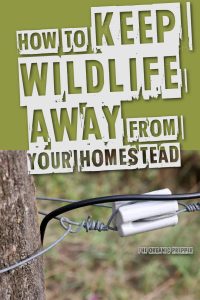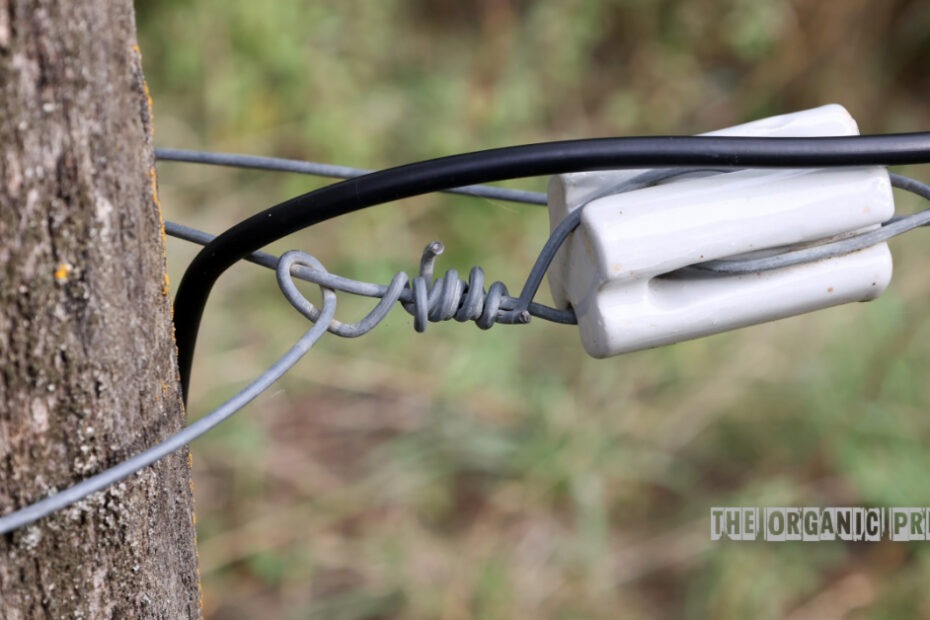(Psst: The FTC wants me to remind you that this website contains affiliate links. That means if you make a purchase from a link you click on, I might receive a small commission. This does not increase the price you’ll pay for that item nor does it decrease the awesomeness of the item. ~ Daisy)
We already talked about all the different species that just love to invade gardens and yards, eating your crops and potentially killing your livestock. I barely even mentioned how to stop them, so that’s exactly what we’ll do in this article on how to keep wildlife away from your homestead.
Electric fences – why aren’t they as effective as people think? How do you keep snakes away? And what’s up with burrowing animals – how do you stop them from digging under a fence?
Let’s get started.
Electric fences: great, but not omnipotent
An electrified fence is going to zap anything that touches it. It’s a great way to keep bears, moose, and deer away, for example. These animals are too large to climb through the gaps between the power lines.
Wolves, however, can get around an electrified fence. They’ll initially be scared away, but they’re persistent animals, and they’ll find a way to go around the fence if they’re motivated enough.
However, if a wolf really wants to get into your yard, it will dig under the fence or carefully move between the lines. Mountain lions are another thing to unpack – they’re incredible climbers (just like all big cats, really), and if a cougar wants to get into your yard, it will find a way.
Maybe it’ll climb a pole or a tree and jump from there, or it will simply jump over the fence (if it’s short enough).
Speaking of jumping – did you know that some deer can jump over a 7-foot fence? This is scientifically proven, believe it or not, so if you’re installing a fence (be it electrified or not), it needs to be taller than that to stop deer.
Finally, we have skunks, raccoons, and snakes. Snakes are too small to be caught by an electric fence (unless a snake gets entangled by accident, which is known to happen), skunks can easily dig a tunnel under a fence if they want to, and raccoons can both climb and dig.
Now, look – the shock value (pun intended) of an electrified fence is a very powerful motivator. Most animals won’t return if they’ve been shocked once. However, some animals can easily bypass your fence, while others are so persistent that they’ll find a way.
That’s why we have to look at other options to keep wildlife away from your homestead.
Get a dog to scare the intruders away
And by that, I don’t mean a pug or a Yorkshire Terrier. Buy (or adopt) a proper home protector, such as a German Shepherd or a Doberman. If you have livestock, you may want a livestock guardian breed such as a Great Pyrenees or an Akbash. (Here are more thoughts on what kind of dog might be best for you.)
Your dog obviously isn’t here to go toe-to-toe with a bear or a pack of wolves. If anything, I’d recommend you bring your dog inside in that situation. Your dog is here to scare the invaders away before they get close. All animals, including bears and wolves, will avoid confrontation with other animals if they can.
Wolves are the most daring of all the animals we talked about, and their (perceived) audacity and arrogance is so big I wouldn’t be surprised if a wolf invaded a yard with more than one dog in it.
However, animals weigh the risks and the benefits before making their moves. For most animals, the potential benefit of getting some food is not worth risking getting into a fight with a large dog (or even worse – dogs).
Dogs are territorial and will let everyone know that this is their yard.
Combining that with an electric fence (something your dog will learn to avoid) should be more than enough to keep the vast majority of wildlife away from your homestead.
Trapping works, but be careful.
If you don’t have a dog and you constantly get animals in your yard, trapping might be a good option. I don’t suggest using traps if you have a dog, as it’s possible your dog will get caught in the trap and hurt itself.
Before we proceed, I want to point out the legality of traps. Some counties or states have very specific laws regarding traps. Make sure to look that up before you buy a trap.
Traps are very effective against raccoons and skunks. You should get either bodygrip or cage traps. Bodygrip traps kill small animals instantly and in most cases, humanely.
If you don’t want to kill the animals in your yard, you can buy cage traps, which trap the animal without hurting it. You can hand it over to the closest animal control center, and they’ll release it into the wild.
Other methods to keep wildlife away from your homestead.

The first one is cleaning your yard and garden. Animals are attracted to food, and although you can’t remove livestock and crops from your home, you can minimize trash and leftovers, which is food for them.
You can also close all gaps they might want to use as shelter (crawl spaces, sheds, and anything similar).
Another thing you can try out is sense-based deterrents. I’m not talking about ‘wolf’ urine – in fact, most ‘wolf’ urine you can buy in stores isn’t really wolf urine, and it rarely works. I’m talking about devices that emit loud noises and strong lights, scaring the animals away. This has some success with ungulates (moose and deer), but it’s possible the animals will get used to it after a while and realize the device isn’t really a threat. There are also motion-detecting sprinkler systems that work as a deterrent against some animals.
Combining these methods with a tall fence (or even better, an electrified tall fence) will be enough to keep most animals away from your homestead.
What are the ways you keep wildlife away from your homestead?
Animals can cause untold damage to gardens, crops, and livestock and it’s imperative to protect your property. How do you keep wildlife away from your homestead? Have you found some preventative methods that work will? Have you tried the ideas listed here?
Let’s discuss it in the comments section.
About Tom
Tom is a former military reconnaissance scout with three years of extensive training and first-hand experience in navigation, first aid, firearms maintenance, combat, and wilderness survival. He is also an avid hiker and all-around outdoorsman, with a lifetime of experience in the wild. Aside from writing and sports, emergency preparedness is one of his biggest interests, and he’s a big believer in being ready for anything the world may throw at you. You may contact him at tomislavlovricwriting@gmail.
